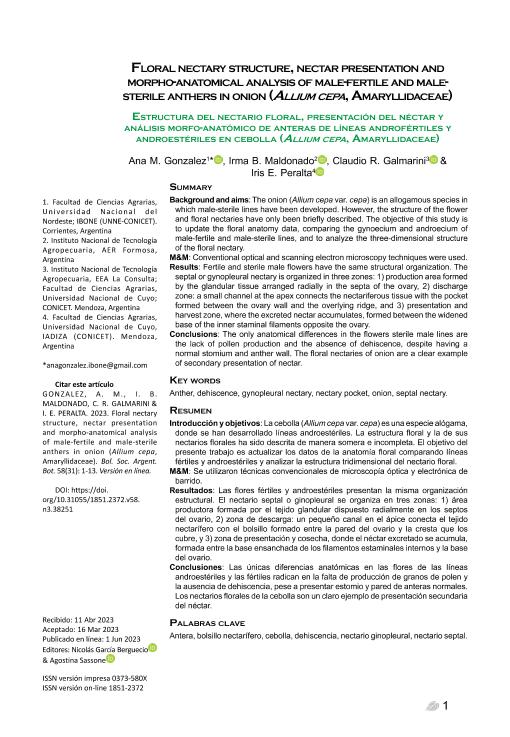Artículo
Introducción y objetivos: La cebolla (Allium cepa var. cepa) es una especie alógama, donde se han desarrollado líneas androestériles. La estructura floral y la de sus nectarios florales ha sido descrita de manera somera e incompleta. El objetivo del presente trabajo es actualizar los datos de la anatomía floral comparando líneas fértiles y androestériles y analizar la estructura tridimensional del nectario floral. M&M: Se utilizaron técnicas convencionales de microscopía óptica y electrónica de barrido. Resultados: Las flores fértiles y androestériles presentan la misma organización estructural. El nectario septal o ginopleural se organiza en tres zonas: 1) área productora formada por el tejido glandular dispuesto radialmente en los septos del ovario, 2) zona de descarga: un pequeño canal en el ápice conecta el tejido nectarífero con el bolsillo formado entre la pared del ovario y la cresta que los cubre, y 3) zona de presentación y cosecha, donde el néctar excretado se acumula, formada entre la base ensanchada de los filamentos estaminales internos y la base del ovario. Conclusiones: Las únicas diferencias anatómicas en las flores de las líneas androestériles y las fértiles radican en la falta de producción de granos de polen y la ausencia de dehiscencia, pese a presentar estomio y pared de anteras normales. Los nectarios florales de la cebolla son un claro ejemplo de presentación secundaria del néctar. Background and aims: The onion (Allium cepa var. cepa) is an allogamous species in which male-sterile lines have been developed. However, the structure of the flower and floral nectaries have only been briefly described. The objective of this study is to update the floral anatomy data, comparing the gynoecium and androecium of male-fertile and male-sterile lines, and to analyze the three-dimensional structure of the floral nectary. M&M: Conventional optical and scanning electron microscopy techniques were used. Results: Fertile and sterile male flowers have the same structural organization. The septal or gynopleural nectary is organized in three zones: 1) production area formed by the glandular tissue arranged radially in the septa of the ovary, 2) discharge zone: a small channel at the apex connects the nectariferous tissue with the pocket formed between the ovary wall and the overlying ridge, and 3) presentation and harvest zone, where the excreted nectar accumulates, formed between the widened base of the inner staminal filaments opposite the ovary. Conclusions: The only anatomical differences in the flowers sterile male lines are the lack of pollen production and the absence of dehiscence, despite having a normal stomium and anther wall. The floral nectaries of onion are a clear example of secondary presentation of nectar.
Floral nectary structure, nectar presentation and morpho-anatomical analysis of male‐fertile and male‐sterile anthers in onion (Allium cepa, Amaryllidaceae)
Título:
Estructura del nectario floral, presentación del néctar y análisis morfo-anatómico de anteras de líneas androfértiles y androestériles en cebolla (Allium cepa, Amaryllidaceae)
Fecha de publicación:
06/2023
Editorial:
Sociedad Argentina de Botánica
Revista:
Boletín de la Sociedad Argentina de Botánica
ISSN:
0373-580X
e-ISSN:
1851-2372
Idioma:
Inglés
Tipo de recurso:
Artículo publicado
Clasificación temática:
Resumen
Archivos asociados
Licencia
Identificadores
Colecciones
Articulos(IADIZA)
Articulos de INST. ARG DE INVEST. DE LAS ZONAS ARIDAS
Articulos de INST. ARG DE INVEST. DE LAS ZONAS ARIDAS
Articulos(IBONE)
Articulos de INST.DE BOTANICA DEL NORDESTE (I)
Articulos de INST.DE BOTANICA DEL NORDESTE (I)
Citación
González, Ana María; Maldonado, Irma B.; Galmarini, Claudio Romulo; Peralta, Iris Edith; Floral nectary structure, nectar presentation and morpho-anatomical analysis of male‐fertile and male‐sterile anthers in onion (Allium cepa, Amaryllidaceae); Sociedad Argentina de Botánica; Boletín de la Sociedad Argentina de Botánica; 58; 3; 6-2023; 477-489
Compartir
Altmétricas




